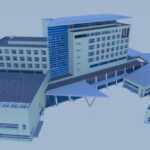An amalgamation of BIM meeting the advanced IOT Technologies constitutes what is so-called the Digital Twin. The construction industry is in the transitioning phase. New challenges, as well as new opportunities, are penetrating the AEC Industry day in and day out. The higher bar of expectation from the BIM Modelling Industry is compelling the need for more and more innovation and the answer to all this lies in the so-called new bim: “The Digital Twin”.
The Many Professional Benefits of Digital Twin
1. Ease of Integrated Data: A bulk processing of data can not only make life difficult but can also cause havoc at the workplace. An easily managed data Integrated with bulk processing is something digital twin can offer within.
2. Data Protection: The cloud sharing mechanism offered by Digital Twin customers are more demanding, and societal expectations are higher. These services can sustain the demand for monitoring and compliance policies as well as key security elements, thereby protecting the shareable data and, at the same time, confidentiality.
3. Data Analysis and Storage for Processing: The immediate availability of data and the cloud storage mechanism helps in a coordinated team analysis with Digital Twin. This helps in discovering the man-induced errors, proliferating any changes in the desired structure as well as storage for future retrieval. BIM Modelling has proven itself as a valuable mechanism for connecting information and ideas between different stakeholders and with the amalgamation of Digital Twin, the benefits seem immense in terms of effective collaboration and coordination.
4. Compatibility of Digital Twin: The ability to create and process the stakeholders involved, including people, places, systems, and devices, the formation of virtual and real (actual) physical assets, processes and all together, induces computational compatibility. The difficulty that lies in rectifying the whole new-built structure can be resolved at an earlier stage with Digital Twin, thereby testing new assets before launching them in reality. The management is completely data-driven.
5. Safety Concern: The various benefits of Digital Twin also take into account safety provisioning, so as in the improvement of sensitive structures such as oil rig or any sensitive units like a production plant or whether to ensure that a building has been built taking into account all the sustainable factors, as the ability of the technology to detect and notify failure before they actually occur and rather suggesting possible solutions for the same is worth betting for.
The growing frame of Technology along with IoT as well the greater need and demand, is diverting the focus more and more towards new methods of hazard prevention, greater coordination, speed of construction, minimising human-based error and of course increase operational efficiency.
6. More Creativity: The different testing approaches can be followed by stimulating the design before implementing in reality or giving it a real sensical approach. This can enhance the creativity of the involved beneficiaries. The authentic feedback generated by the use of the technology is something that can aid in better management and structurization. The well-coordinated model can drive a better output.
7. AI, Predictive Outcome and Continuous Management: The probability of continuous monitoring of the project as well the integration of Artificial Intelligence in BIM modeling coupled with Digital Twin has the potential to open new horizons for the AEC and Construction Industry as a whole thereby bringing a new BIM Revolution.
Conclusion:
Companies that can realise the future savings from intelligent data systems can rip apart the competition in the BIM Industry and can reap the truly transformative benefit of the new advanced methodology by “Digital Twin.”



